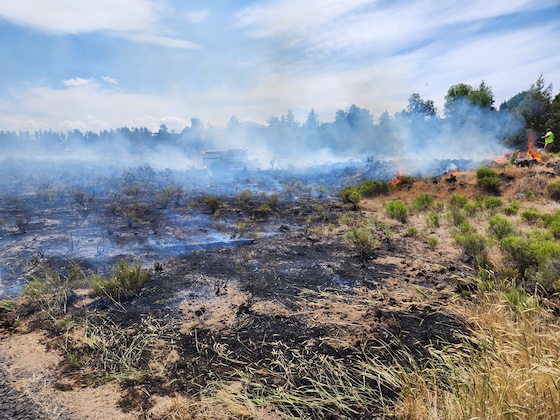Flashback: Surveying fallout shelters in 1970 and looking forward to telehealth in 1995
Published 3:49 pm Thursday, July 16, 2020

- Brian Buckingham looks at a computer-transmitted CT scan in this 1995 photo.
100 years ago
July 22, 1920 — Art Tuck’s Telegram Asks ‘Hurry Up’ on His Overcoat
Arthur Tuck of Redmond, selected to make the trip to Antwerp as a member of the American Olympic team, will sail from the Atlantic coast July 26, according to a telegram received Tuesday by his father, John Tuck.
In the hurry of leaving for Boston after a short visit here two weeks ago, Art forgot his overcoat. The telegram calls for the overcoat at once, also his robe which he contemplates wearing at Antwerp when he contests in the javelin throw next month.
75 years ago
July 26, 1945 — Harold McDonald Dead Since 1942
Cpl. Harold McDonald, son of Mr. and Mrs. Frank McDonald, died July 28, 1942, while a prisoner of war of the Japanese government, states a telegram received a few days ago from the war department. His death occurred on the Philippine islands as a result of starvation and complications, the McDonalds were informed.
Harold McDonald was born at Scio April 5, 1915, and came to central Oregon with his parents in 1918. He started grade school under Miss Jessie L. Hill and was graduated from the eighth grade in Redmond when John Tuck was principal. He entered Redmond union high school, but transferred to Salinas, Cal., high in his junior year and was graduated in 1933 and re-enlisted in the army in 1940, being sent overseas September 5, 1941. The last letter his parents received from him was written from Bataan in May, 1942.
He has a brother, Clarence, gunner’s mate third class, who is serving overseas with the navy. Keith McDonald, owner of Redmond bakery, also is his brother, and there are many other relatives in Redmond and vicinity. A brother Byron, lives in Portland, and another, M.R. McDonald, in Salinas, Cal.
50 years ago
June 22, 1970 — Army engineers surveying public fallout shelters
The Portland division of the Army Corps of Engineers has a crew in Deschutes County to survey and update about 25 new and remodeled structures for safe, protected spaces available to the public should an atomic attack occur upon the United States, it has been announced by W. Lester Houk, director of the county’s department of emergency services.
The men will be here from 10 days to two weeks, surveying and updating existing designated public fallout shelters. In Redmond they will survey the new high school, armory, Lantz building, Masonic Temple, Central Electric Cooperative building, potato cellars and any other shelters they can locate. Not all will qualify, however.
The last survey was made in 1962. This is a priority program and is being done under supervision of Robert Thuring, shelter engineer for the Corps of Engineers. He is assisted by four college architectural and engineering students working on a summer job project of the corps. The students are Stewart Smith, Richard Hensley and William Eastin, of Moscow, Idaho, and Mike Costello of Los Angeles.
Results of the updating survey will be analyzed by the Oregon state fallout shelter planner, who will finalize and return the completed data to Houk for action.
Food and supplies for public fallout shelters are furnished by the federal government and placed in the licensed shelters for use in time of national emergency.
Houk suggests that now is the time for all residents to obtain a copy of the new publication, “In Time of Emergency,” by calling at the courthouse or requesting a copy by mail. This should be studied, then placed in a handy lace for reference, if needed, he says.
25 years ago
July 26, 1995 — Teleconferencing health
The technology to link patients in their homes with doctors in hospitals may not be too far in the future.
“Someday we’re going to carry a TV camera with us,” community health nurse Gerrie Melton says, “and we’ll film the exam, and the physician will see the person live. We’ll be reporting the actual signs and symptoms, and they’ll see how a patient’s limb moves.”
As home health care supervisor for St. Charles Medical Center in Bend and Central Oregon District Hospital in Redmond, Melton has seen technological advances that make it possible for patients to receive many services and treatments at home that previously would have required a trip to the hospital or doctor’s office.
Before hospitals hook up with a patient’s home, the first step will be connecting with each other via state-of-the-art teleconferencing systems. Such a system is in the works for CODH and St. Charles.
Mike Severns, director of facility services and technology management for St. Charles, said an interactive network between the two hospitals is scheduled for a test hookup this fall. Eventually, he said, the system would be developed into a regional medical network linking hospitals across Central and Eastern Oregon.
Physicians treating patients in Burns or Lakeview, for example, could consult with specialists and surgeons in Bend or Redmond “via an interactive video network, which would save all that travel time and expense,” Severns said.
The article continues on redmondspokesman.com.
He said the hospitals are working with US West to install the infrastructure of the network — a fiber optic system capable of transmitting live video broadcasts and high-resolution medical images such as x-rays.
“The images on this would be of diagnostic quality,” Severns said. “A lot of different medical devices can be used, anything with a video output or any medical device that has a computer attached to it. We can hook up microscopes and cameras, and zoom in on a patient’s wound.
“It’s an incredible technology, and these networks are springing up everywhere across the country.”
Dr. David Tretheway said physicians at CODH and St. Charles already are able to exchange medical images such as ultrasounds and CAT scans via computer modem.
Severns visited a Portland hospital recently to watch a demonstration of a medical network hookup with a hospital in Austin, Texas.
“They demonstrated several medical devices over the network, and the image quality was incredible,” he said.
The medical network will have a broad range of uses, and physicians will be able to develop their own applications. In the future, that could provide patients in their homes unprecedented access to doctors in hospitals all over the state, or the country.
“The future of medicine is it’ll be coming to the home,” Severns said. “It will happen. It might be five years or 10 years, we don’t know, but the technology is moving in that direction.”









